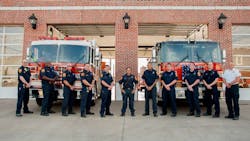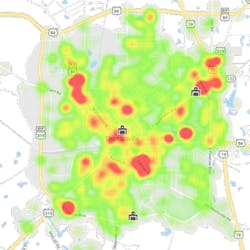Industry Expert Blog: How One Department's CRR Plan Reduced Calls by 35 Percent
How One Fire Department Reduced Fire Calls by 35 Percent with Their Community Risk Reduction Plan
Thomasville Fire Rescue (TFR), serving the largest city in Thomas County, Georgia, shared some impressive facts in their 2018 Four Year Report that highlighted the effectiveness of their Community Risk Reduction efforts. Through the utilization of Emergency Reporting (ER), the leading cloud-based records management and reporting software for fire departments, along with a combination of community education and fire prevention, TFR helped contribute to a 35 percent decrease in fire calls over the span of four years. Read on to find out more about how they achieved this, and what other fire departments can take away from their story to help their own community risk reduction plan succeed.
TFR is an all-hazards fire and rescue department that is committed to providing exceptional public safety services. They have an impressive list of capabilities that enable them to keep citizens safe, including fire suppression, emergency medical response, public education, fire investigation, fire prevention, and hazard risk reduction. The City of Thomasville is located in southwest Georgia and has a population of 18,826. With an annual budget of 3.5 million, TFR utilizes five fire response companies, operating out of three fire stations, and is staffed with 42 uniformed men and women.
According to their Four Year Report, TFR has experienced a substantial decrease in the number of fire-related calls within their district from 2014 – 2017. Building fires were down by over 40 percent, other fires (e.g., outside, rubbish, and grass) were down by 50 percent, and vehicle fires remained approximately the same. All of these things equate to an average reduction in fire calls of over 35 percent!
So how did TFR achieve this incredible reduction in calls? They performed a Community Risk Assessment to identify their needs, began focusing greater attention on the integration of risk management in fire prevention, and developed community education programs based on fire prevention.
A Community Risk Assessment is a process used to identify and evaluate hazards in the community, determine their probability, and assess their impact if they were to occur. During this process, TFR relied heavily on their Emergency Reporting software to run reports and retrieve stored data about their department and the community.
Data, including fire loss, injury and life loss, property loss, and other associated losses, are all recorded in the ER records management platform. Utilizing ER’s response assessment tools, TFR has been able to identify trends in their data and determine where to focus their prevention efforts for the highest efficiency. Below is a useful heat map from the Incidents Module in ER that assisted TFR in this process by showing the density and location of fires in their response area. To view the full Thomasville Fire Rescue Four Year Report click here.
Reducing the probability of fires in a structure can be accomplished most effectively by on-site visits that include performing inspections and developing pre-fire plans. After switching to ER in 2014, TFR was able to use the Occupancy Module to increase the tracking and efficiency of annual fire inspections, plan
reviews, code enforcement, and pre-incident fire planning. The Occupancy Module has also allowed TFR to develop a detailed database of fire hydrants, occupancies, fire protection systems, hazards, assessed values, jobs, and more. This extensive database gives them the ability to complete a detailed analysis of their service area. This analysis effectively aids in decision-making and planning for the future needs of the organization.
Once that data is loaded into ER, the VISION Risk Assessment Module is handy for helping analyze the data and categorizing the risks based on the probability and impact. The VISION Module uses a weighted Occupancy Vulnerability Assessment Profile (OVAP) score to collect and analyze data for a risk assessment. The score is established by examining the construction type, size, height, fire resistance classification, fire protection systems, square footage, and water flow requirements. After the OVAP scores have been established, each occupancy is color-coded based on risk and included within the Google Maps integration for a helpful visual reference.
If your department is like most around the country, you are likely feeling pressure to accomplish more with less. To satisfy this requirement, fire service personnel must find new and creative ways to make their resources stretch further. TFR is a perfect example of a department utilizing their records management software and making a couple of simple, strategic changes to accomplish this goal. By increasing efficiency and using community education and fire prevention, TFR is now able to focus more of their time and resources on other goals and responsibilities to best serve their citizens. If it sounds like your department would benefit from using Emergency Reporting, click here for a free trial.
About Emergency Reporting
Emergency Reporting (ER) offers a powerful, cloud-based records management software (RMS) solution to Fire/EMS agencies worldwide. Founded in 2003, ER empowers first responders with secure, easy-to-use station management tools that offer one-report filing of NFIRS and NEMSIS data. ER’s affordable SaaS solution allows Fire/EMS departments to run their entire operations efficiently and effectively, enhancing both firefighter and citizen safety. ER is proud to support more than 460,000 first responders at thousands of civilian Fire/Rescue and EMS agencies and DoD/military installations, as well as large entities with self-contained Fire/EMS services such as NASA, nuclear power plants, hospitals, and oil refineries. For more information, visit emergencyreporting.com.


